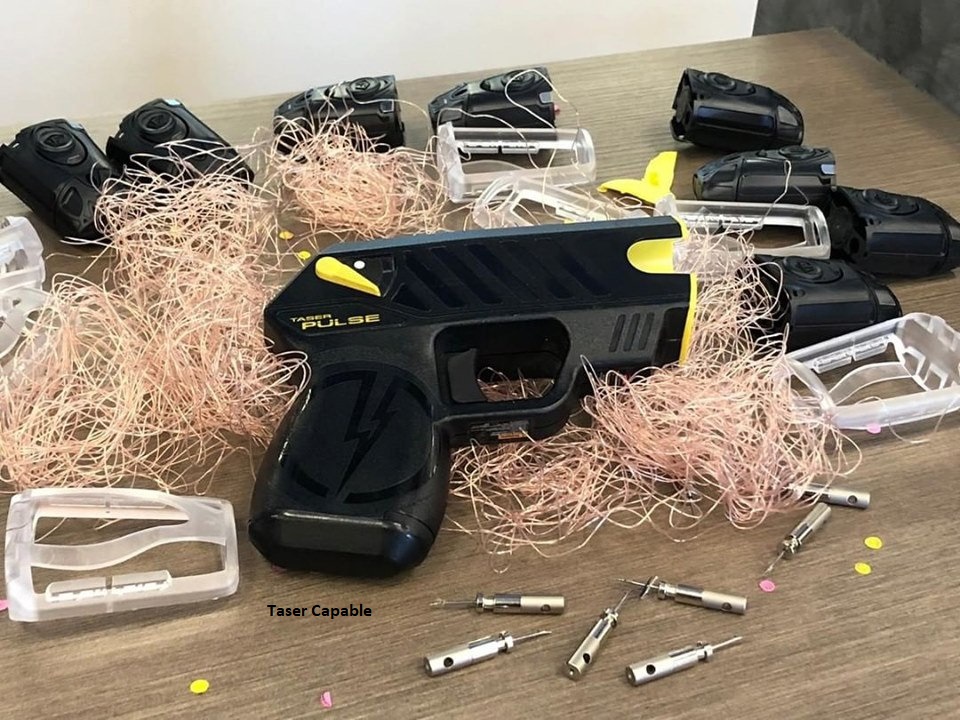Introduction
Personal safety is a top priority for people from all walks of life in the modern world. The widespread use of tools like tasers is a result of the demand for non-lethal self-defense choices. These electroshock weapons are become more and more popular since they work well and pose little danger of doing major damage. In this post, we’ll examine the idea of “Taser Capable” to learn what it means, how these tools operate, what they’re used for, and what the law says about them.
What is a Taser
A Taser, also known as Thomas A. Swift’s Electric Rifle, is a non-lethal self-defense tool that renders a victim immobile by shocking it with a strong electric current. It is intended to interfere with the target’s neuromuscular system, momentarily immobilizing them.
How Does a Taser Work
Tasers work by injecting the target with two electrically charged probes. Thin wires link these probes to the apparatus. An electrical circuit is completed when the probes make contact, allowing a high-voltage, low-amperage electrical pulse to pass into the body of the target. Due to the disruption of the muscles’ and neurological system’s regular operations, this results in excruciating pain and immobility
Handheld Tasers
Tasers that can be carried about easily are called handheld tasers. Both individuals and members of law enforcement frequently utilize them for Taser Capable self defens. To dissuade possible threats, handheld tasers are frequently made to seem like weapons.
Taser Capable Stun Guns
Another type of electroshock weapon is a stun gun. Stun weapons, as opposed to conventional tasers, demand physical contact with the target. They come in a variety of sizes and shapes and are frequently employed for close-range self-defense.
Law Enforcement
Tasers have grown to be an important weapon for law enforcement organizations all over the world. They give officers a non-lethal way to take down offenders, lowering the possibility of fatal interactions. To prevent abuse, its use is constrained by stringent rules and restrictions.
Civilian Self-Defense
Tasers are frequently carried by civilians for personal safety. Particularly in places with high crime rates, these gadgets might give one a feeling of protection. Individuals Taser Capable must comprehend the laws that apply to their use in their various areas, nevertheless.
Restrictions on Taser Use
Tasers provide a less lethal alternative to weapons, but their usage is subject to certain legal restrictions. Different jurisdictions have different laws governing the ownership and Taser Capable application of tasers. Some areas could demand permissions or limit their use to certain areas.
Ethical and Moral Concerns
Taser use has prompted ethical concerns regarding the possibility of abuse or Taser Capable disproportionate force. To address these issues, it is essential to guarantee responsible use and respect to rules.
Conclusion
The ability to employ a taser for self-defense is referred to as having a “Taser Capable” gadget. Responsible ownership requires an understanding of the Taser Capable various types, uses, and mechanics of tasers. It is essential to follow local rules and ordinances and to think about the moral ramifications of using such a potent tool. Tasers can help to increase personal safety when used sensibly and legally.
FAQs
- Are tasers legal for civilians to carry?
Taser laws vary by jurisdiction. It’s essential to research and understand the regulations in your area before carrying one.
- Can tasers cause permanent harm?
Tasers are designed to be non-lethal, but they can cause injury in some cases. It’s crucial to use them responsibly and aim for self-defense rather than harm.
- How effective are tasers in stopping an attacker?
Tasers are generally effective in incapacitating an attacker temporarily. However, their effectiveness can depend on factors such as the attacker’s size and clothing.


